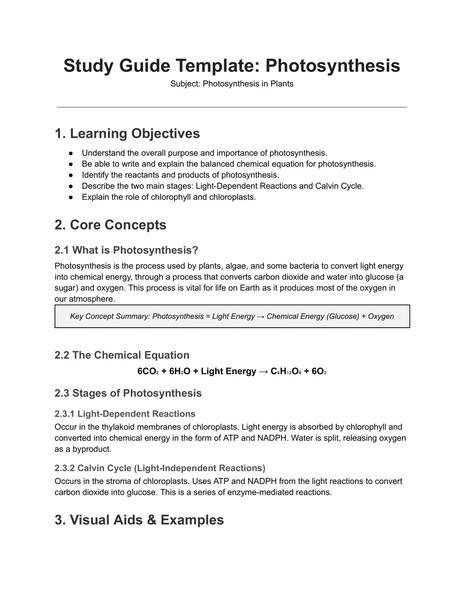This Google Docs study guide template offers a structured framework to enhance learning and information retention. It is designed for clarity and active engagement, moving beyond passive note-taking to a more dynamic study process.
Features:
Clear Learning Objectives: Sections to define specific learning goals.
Concise Content Areas: Space for focused summaries and key concept breakdowns.
Visual Aid Integration: Placeholders and suggestions for diagrams and visual elements.
Active Learning Prompts: Built-in questions, self-assessment quizzes, and worked example formats.
Study Strategy Guidance: Tips on effective learning techniques.
Organized Resources: Sections for glossaries and further learning materials.
Who is this template for?
This template is beneficial for students at any level, individuals pursuing self-study, or educators developing structured learning materials.
When should it be used?
Utilize this template when preparing for examinations, seeking to understand complex subjects in detail, organizing study notes, or creating comprehensive review sheets for any topic.
Format: Google Docs
How To Use This Study Guide Template
To begin using this resource, select the "Use Template" button, typically found in the upper right corner of the document preview page. A Google account is necessary to create and save your personal copy of the template in Google Docs.
Effectively Customizing Your Study Guide
Replace Sample Content: The template contains placeholder information (e.g., on "Photosynthesis"). Systematically replace this with your specific subject matter, data, and examples.
Adapt Sections: Tailor the headings and sub-sections to match the unique structure and requirements of the topic you are studying. Not all sections may be relevant for every subject; feel free to modify or remove them as needed.
Populate Learning Objectives: Clearly define what you aim to understand or achieve by studying the material. This focuses your efforts.
Utilize Active Learning: Engage thoroughly with the practice questions, self-assessment quizzes, and worked example sections. These are designed to reinforce understanding, not just test memory. Try to answer prompts before referring to your notes.
Incorporate Visuals: Where indicated, or where beneficial, insert diagrams, charts, or mind maps. Visual information can significantly aid comprehension and recall.
Maintain Clarity: When adding your content, strive for clear and concise language. Avoid overly complex sentences or jargon where simpler terms suffice. The goal is understanding, not just transcription.
Review and Iterate: Your study guide is a dynamic tool. Revisit and refine it as your understanding of the subject evolves. Add new insights or clarify points that were initially confusing.
Important Considerations
Focus on Understanding: The template is a tool to facilitate learning. The primary effort should be on comprehending the material, not just filling in the blanks.
Consistency: If adding new sections, try to maintain a consistent formatting style for readability.
Avoid Passive Use: Resist the urge to simply copy-paste information. The act of rephrasing, summarizing, and engaging with the active learning components is crucial for effective study.




